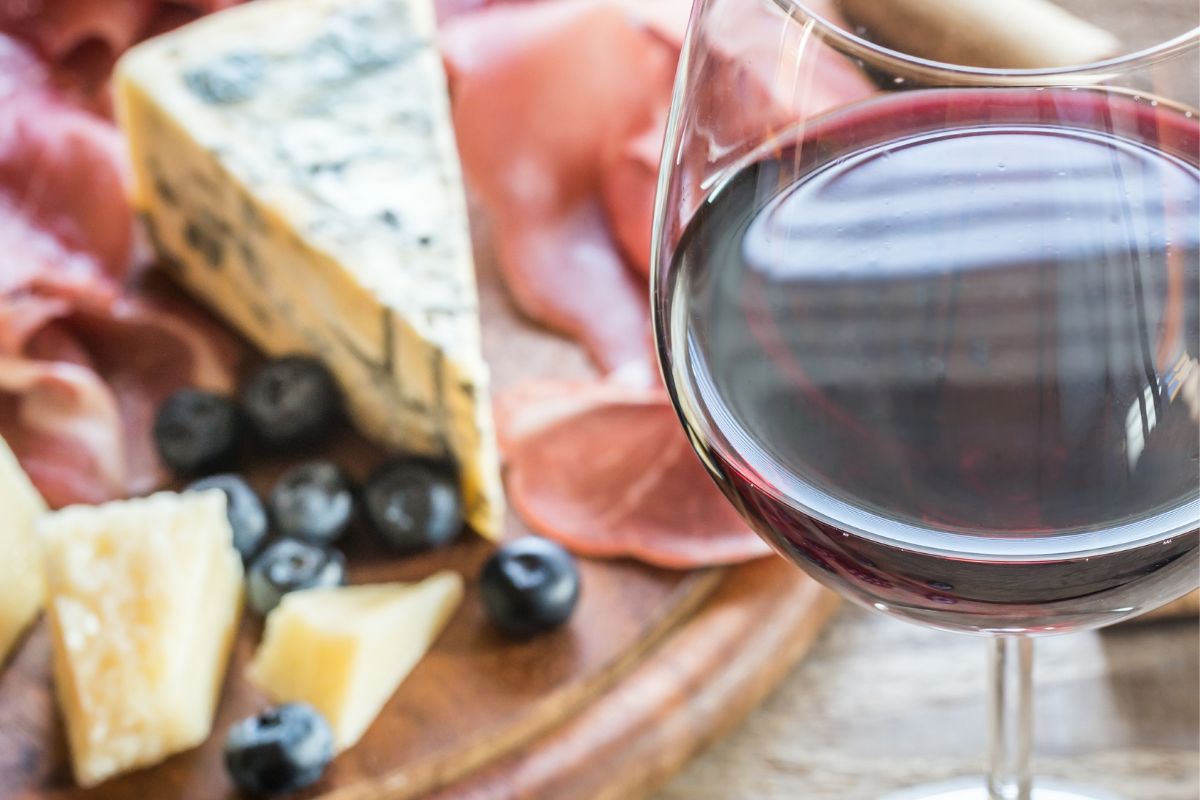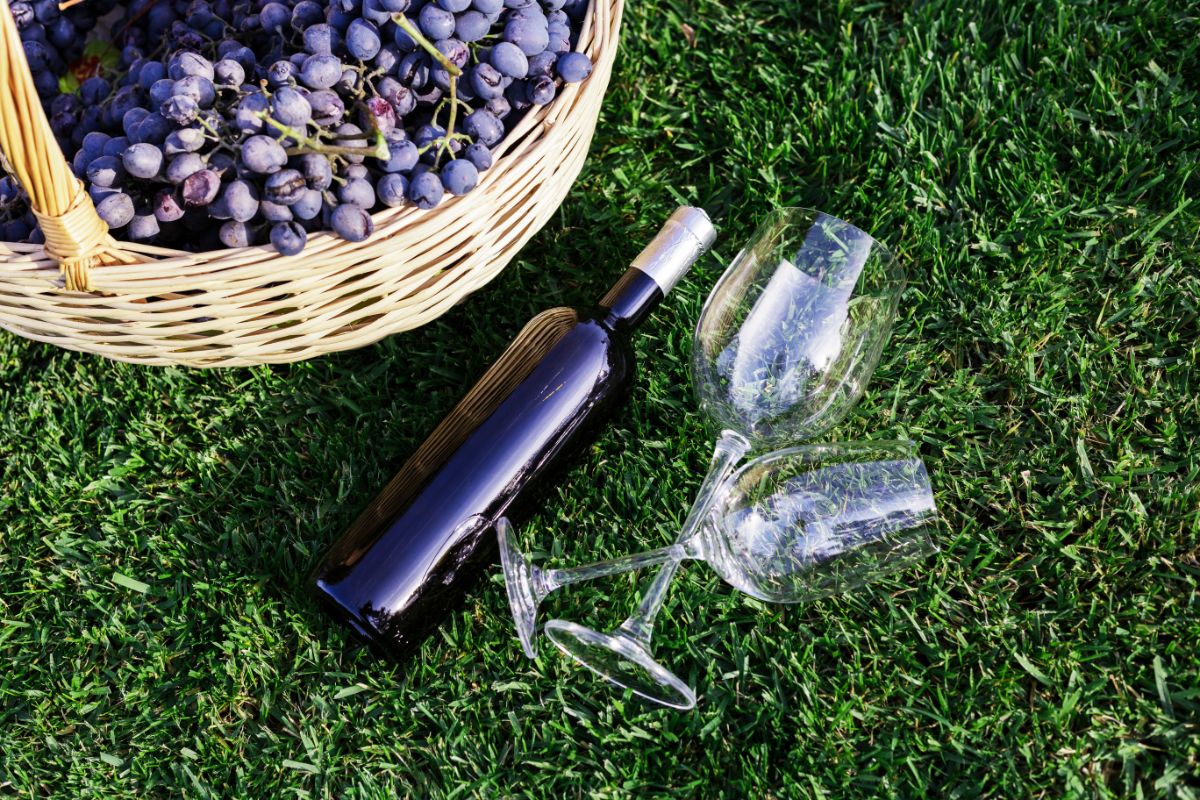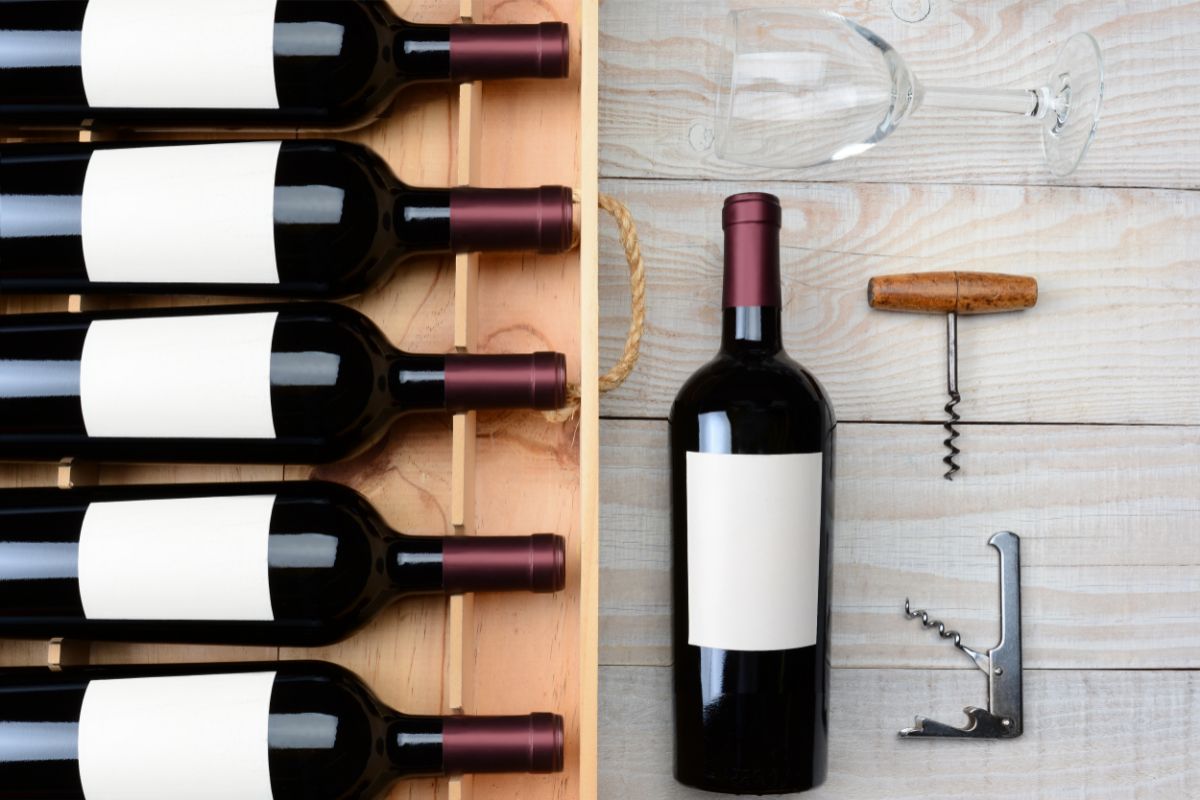Sangiovese is one of the most popular red wine grape varieties found in Italy.
This versatile and delicious grape is used in the production of many popular wines, so any wine lover should aim to be familiar with the flavor profile and pairing guidelines for Sangiovese.

This is your complete guide to Sangiovese wine. We will be covering the history of the grape, the flavors and aromas you can expect from this wine, and serving suggestions to help you get the most out of each glass.
What Is Sangiovese Wine?
Sangiovese wine is an umbrella term for wine made from the Sangiovese grape variety. Sangiovese grapes are a cornerstone of Italian wine culture, and they can be found growing all over the country.
This grape is most popular, however, in the Romagna, Campania, and Umbria regions of Italy.
In addition to growing plentifully on Italian soil, Sangiovese grapes can be found in France, Australia, Argentina, and the United States.
Sangiovese wine tends to be medium-bodied due to the medium-high tannin content of the grape.
It’s typically a stronger wine compared to other red wines, and it’s also usually more acidic. You might compare its body and flavor profile to a more acidic version of Merlot.
Bear in mind that Sangiovese wine is usually not named as such once it has been bottled.
Just some of the most popular wines made with Sangiovese grapes include Chianti, Prugnolo Gentile, Vino Nobile di Montepulciano, Morellino di Scansano, Montefalco Rosso, and more.
Note: Chianti wine always contains Sangiovese grapes, but it also contains other grape varieties, such as Merlot and Cabernet Sauvignon.
About Sangiovese Grapes
Sangiovese wines can taste and smell differently depending on aging methods and other grapes that may have been blended with the Sangiovese grapes.
However, Sangiovese grapes themselves are consistent in the traits they have, regardless of which part of the world they are grown in.
One thing that makes Sangiovese grapes easy to identify by sight is their light color. While these are red grapes, they don’t have the same deep red or purple color that other red wine grapes do.
You might also notice that Sangiovese grape skins are relatively thin. This can be hard to see if you’re not an expert in grape varieties, but the skins of Sangiovese grapes are more delicate than most.
Sangiovese grapes have particularly long growing seasons, which means they can be grown and harvested plentifully throughout the year.
They’re also hardy and are able to tolerate various weather conditions, which is why they can be grown in so many parts of the world, despite being most common in Italy.
Another identifying feature of Sangiovese grapes is their fine tannins. Although Sangiovese wine is tannic, the tannins in the grape are fine rather than ‘green’.
This means that they have a velvety mouthfeel and won’t taste bitter.
History Of Sangiovese Wine
The history and mythology surrounding Sangiovese wine are fascinating. The name ‘Sangiovese’ has been translated to ‘blood of Jove’.
This is a reference to the Roman God, Jupiter. This name may have been chosen by the monks of Santarcangelo di Romagna, but this has not been confirmed.
The concrete history of this grape and wine is still being debated by historians, however.
It is thought that the Sangiovese grape dates back to wine-making during the Roman era, and some experts have even suggested that it was originally grown in Tuscany by the Etruscans.
Accounts of Sangiovese are thought to date back to 1590, when Giovanvettorio Soderini wrote about a grape named ‘Sangiogheto’, claiming that it could produce delicious wine, but also develop an unpleasant, vinegar-like taste if handled incorrectly.
It is widely accepted that allusions to ‘Sangiogheto’ are referring to Sangiovese.
It was only in the 1700s that Sangiovese became well-known in Italy, first rising to popularity in Tuscany, where it is now the most-cultivated variety of grape in the region.
Sangiovese Wine Flavor Profile

While Sangiovese can take on many different flavors, it is primarily known as a savory wine. Although it has a reputation for being something of a chameleon in terms of flavor, its primary flavors are typically cherry with a hint of tomato.
Most Sangiovese wine has a rustic, somewhat earthy flavor, although some Sangiovese blends can have more of a fruity profile.
You’ll notice that despite its mostly savory flavor, the aroma of Sangiovese is more fruity and floral.
Some of the aromas you’re likely to identify include fig, cherry, strawberry, plum, and rose.
However, you will also encounter some savory notes, including herbs such as thyme and oregano, tomato, roasted pepper, smoke, clay, and tobacco.
How To Serve Sangiovese Wine
Sangiovese wine is one of the finest wine varieties you’ll ever taste – provided that you know how to serve it correctly.
As with any wine, the way it is served and the foods it is paired with have a profound impact on the overall tasting experience.
Serving Temperature
Because Sangiovese is a red wine, many people assume that it does not need to be chilled before serving.
However, the correct serving temperature for Sangiovese wine is between 59 and 65 degrees Fahrenheit, which translates to 15 to 18 degrees Celsius.
Since this temperature range is a few degrees below room temperature (which is 68 to 72 degrees Fahrenheit, or 20 to 22 degrees Celsius), it is best to slightly chill Sangiovese wine before serving.
Because a regular refrigerator stands at around 40 degrees Fahrenheit, or 5 degrees Celsius, you won’t want to use this kind of cooling appliance for Sangiovese.
Keeping Sangiovese at standard refrigerator temperatures for more than a few minutes would result in it becoming far too cold.
Instead, we recommend investing in a wine refrigerator, which is a more accurate and purpose-built appliance for keeping your wine at the correct temperature.
Wine Glass Recommendation
The fact that Sangiovese is a red wine can also cause some confusion regarding the proper type of wine glass for serving.
Although many red wines are best served in large-bowled wine glasses for aroma-enhancing purposes, this is not strictly necessary for Sangiovese.
The reason for this is that while Sangiovese does have pleasant and varied aromatic notes, it is not considered to be a particularly aromatic wine.
Therefore, it is perfectly fine to serve Sangiovese wine in a regular wine glass – although there is also no problem with using a large-bowled glass if that is all you have available.
Food Pairings
All wines have a unique flavor profile that works better with some foods than others, and Sangiovese is no exception. Serving Sangiovese with the wrong food can alter the taste experience significantly.
To make matters more complicated, different Sangiovese wines may have varying levels of tannins, which impacts which foods it should be served alongside.
It’s also a good idea to consider the aroma of the wine, as well as the flavor, when choosing food pairings.
Assuming that your Sangiovese wine is high in tannins, it should pair beautifully with potent cheeses, roast meats, and sausages.
The acidic aroma with hints of thyme and oregano also means that Sangiovese works beautifully with tomatoes and herbs.
If your goal is to make Sangiovese wine taste less acidic, we recommend pairing the wine with rich and fatty foods, such as olive oil and butter.
Meanwhile, roast vegetables without added sugars can help to bring out the fruity notes of Sangiovese wine.
Sangiovese Wine Alternatives

If you love Sangiovese wine but can’t find it on the wine list or aren’t able to purchase any, there are plenty of delicious alternatives. Here are our recommended alternatives to Sangiovese wine:
Tempranillo
Tempranillo wine is the perfect alternative if your favorite Sangiovese wines are Rosso di Montepulciano or Rosso di Montalcino.
This is a Spanish wine that can have the same body as Sangiovese if it is not oak-matured. It also has notes of red fruit, such as cherry, which are similar to those found in Sangiovese wine.
There are also savory notes of tobacco and leather which are reminiscent of the taste of Sangiovese.
While Sangiovese is best served with roasted meats or preserved meats such as sausages, Tempranillo might be a good alternative if you’d like to experience similar flavors alongside smoked or barbecued meats.
Barbera
If you love Sangiovese and haven’t tried Barbera, you should make a point to sample a glass of this Italian red wine.
Most popular in the Piedmont area of Italy, Barbera has a very similar flavor to Chianti. It’s fruitier than your average Sangiovese wine, but its central cherry notes and tannic acidity mean the flavor is still comparable.
Like Sangiovese, Barbera wine goes beautifully with tomatoes, cheese, and herbs. So, if you’re planning to enjoy a delicious pizza, Barbera is the perfect Sangiovese-adjacent wine pairing.
Shiraz
Shiraz, also known as Syrah, depending on what country you’re in, has similar dark fruit notes to Sangiovese.
Despite its subtle fruitiness, Shiraz has a savory flavor profile, which means it’s an excellent alternative to Sangiovese.
This is the ideal wine to pair with meat, especially if the meat has been seasoned with herbs. That’s because, like Sangiovese wine, Shiraz has distinct notes of dried herbs.
We specifically recommend trying Shiraz as an alternative to Sangiovese if you’re sitting down for a meal of grilled red meat, such as beef or lamb.
Whereas Sangiovese tends to pair better with roasted meat, Shiraz complements grilled meat flavors beautifully.
Zweigelt
If you love both Sangiovese wine and seafood, you might find yourself in a conundrum. Sangiovese, like most red wines, does not typically pair well with seafood.
However, Zweigelt is one of the very few red wines in the world that goes excellently with seafood dishes, and it also happens to taste and smell similar to Sangiovese in many ways.
Zweigelt is an Austrian wine with dark fruit notes, including cherry, and a subtle hint of licorice. However, it’s ultimately a savory wine, with notes of black pepper and spices coming through with each sip.
This wine has a similar body to Sangiovese, and like the Italian wine, one of its ideal food pairings is tomato.
Any seafood dish prepared in a tomato sauce will go beautifully with Zweigelt, and you can also try it with white meats that aren’t usually recommended for Sangiovese, such as chicken.
Final Thoughts
Sangiovese wine refers to wine made from Sangiovese grapes. Sangiovese grapes are native to the Tuscany region of Italy, but they are grown all over the country and in many other parts of the world.
These grapes are used to make many popular wines, from Chianti to Moltefalco Rosso.
While each individual wine made from Sangiovese grapes will taste unique, Sangiovese wines all tend to share cherry and dark fruit notes alongside savory notes of dried herbs, tomato, and tobacco.
Its flavor is comparable to wines like Barbera and Tempranillo.
Sangiovese is a medium-bodied, velvety wine that is best served a few degrees below room temperature in a standard wine glass, and pairs well with roast meats, pungent cheeses, and lipids like butter or olive oil.
Frequently Asked Questions
‘Sangiovese’ is pronounced ‘san-joe-ve-zay’
Yes, Sangiovese grapes make for strong wines. The exact alcohol percentage will vary depending on the specific wine, but most Sangiovese wines fall between 13% and 14%.
Sangiovese is usually a medium-bodied wine that can also be light-bodied depending on the aging methods. Despite having fruity notes coming from plum, cherry, and currants, it is not a sweet wine. In fact, it is quite dry
No. Sangiovese wine and Cabernet Sauvignon have some similarities, but they are different wines. Sangiovese has fruitier notes than Cabernet Sauvignon.
The latter has some of the same savory notes as the former, including tobacco and leather, but it also has some woody notes such as cedar. Cabernet Sauvignon also has a hint of vanilla, which isn’t typically identified in Sangiovese wines.
- Why Does Wine Taste Better With Age? - June 14, 2023
- What Does It Mean When A Bottle Of Wine Is Corked? - June 14, 2023
- Wine Fridge Vs Wine Cellar – Which One Should You Choose? - June 14, 2023
